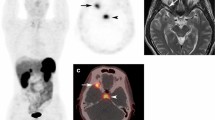Abstract
Tumor-induced osteomalacia (TIO) is a rare paraneoplastic syndrome caused by small benign tumors of mesenchymal origin also known as phosphaturic mesenchymal tumors mixed connective tissue variant. Excellent prognosis is expected with eradication of the culprit tumor. These small tumors are notoriously difficult to localize with conventional imaging studies; this often leads to an extensive work up and prolonged morbidity. We report a patient with clinical diagnosis of TIO whose culprit tumor was localized with Ga-68 DOTATOC PET/CT and MRI. Biopsy and cryoablation were performed under Ga-68 DOTATOC PET/CT guidance. Autoradiography of the biopsy specimen was performed and showed in situ correlation between Ga-68 DOTATOC uptake and histopathology with millimeter resolution.



Similar content being viewed by others
References
Hautmann AH, Hautmann MG, Kölbl O, Herr W, Fleck M. Tumor-induced osteomalacia: an up-to-date review. Curr Rheumatol Rep. 2015;17(6):1–6.
Houang M, Clarkson A, Sioson L, Elston MS, Clifton-Bligh RJ, Dray M, Ranchere-Vince D, Decouvelaere AV, de la Fouchardiere A, Gill AJ. Phosphaturic mesenchymal tumors show positive staining for somatostatin receptor 2A (SSTR2A). Hum Pathol. 2013;44(12):2711–8.
Agrawal K, Bhadada S, Mittal BR, Shukla J, Sood A, Bhattacharya A, Bhansali A. Comparison of 18F-FDG and 68Ga DOTATATE PET/CT in localization of tumor causing oncogenic osteomalacia. Clin Nuclear Med. 2015;40(1):e6–10.
Ryan ER, Thornton R, Sofocleous CT, Erinjeri JP, Hsu M, Quinn B, Dauer LT, Solomon SB. PET/CT-guided interventions: personnel radiation dose. Cardiovasc Interv Radiol. 2013;36(4):1063–7.
Williamson MJ, Dauer LT. Activity thresholds for patient instruction and release for positron emission tomography radionuclides. Health Phys. 2014;106(3):341–52.
Ryan ER, Sofocleous CT, Schöder H, et al. Split-dose technique for FDG PET/CT-guided percutaneous ablation: a method to facilitate lesion targeting and to provide immediate assessment of treatment effectiveness. Radiology. 2013;268(1):288–95.
Hesse E, Rosenthal H, Bastian L. Radiofrequency ablation of a tumor causing oncogenic osteomalacia. N Engl J Med. 2007;357(4):422–4.
Tutton S, Olson E, King D, Shaker JL. Successful treatment of tumor-induced osteomalacia with CT-guided percutaneous ethanol and cryoablation. J Clin Endocrinol Metab. 2012;97(10):3421–5.
Weber MA, Sprengel SD, Omlor GW, Lehner B, Wiedenhöfer B, Kauczor HU, Rehnitz C. Clinical long-term outcome, technical success, and cost analysis of radiofrequency ablation for the treatment of osteoblastomas and spinal osteoid osteomas in comparison to open surgical resection. Skelet Radiol. 2015;44(7):981–93.
Fanchon LM, Dogan S, Moreira AL, Carlin SA, Schmidtlein CR, Yorke E, Apte AP, Burger IA, Durack JC, Erinjeri JP, Maybody M. Feasibility of in situ, high-resolution correlation of tracer uptake with histopathology by quantitative autoradiography of biopsy specimens obtained under 18F-FDG PET/CT guidance. J Nucl Med. 2015;56(4):538–44.
Acknowledgments
This research was funded in part through the NIH/NCI Cancer Center Support Grant P30 CA008748. 68Ga-DOTATOC was provided by Memorial Sloan Kettering Cancer Center institutional protocol 14-226 “68Ga-DOTATOC for imaging of Neuroendocrine tumors: Expanded access trial.” Quantitative autobiography of biopsy specimen was made available by Memorial Sloan Kettering Cancer Center institutional protocol 12-072 “Evaluation and Improvement of PET Accuracy for Tumor Targeting Using Autoradiography and Pathology Tests of Biospecimens from Patients Undergoing PET/CT Guided Biopsy.” Special thanks to Mr. Lawrence T. Dauer, PhD, from Department of Medical Physics, Memorial Sloan Kettering Cancer Center for guidance about the operator dose.
Author information
Authors and Affiliations
Corresponding author
Ethics declarations
Conflict of Interest
On behalf of all authors, the corresponding author states that there is no conflict of interest.
Ethical Approval
All procedures performed were in accordance with the ethical standards of the institutional and/or national research committee and with the 1964 Helsinki declaration and its later amendments or comparable ethical standards.
Informed Consent
Informed consent was obtained for all procedures.
Rights and permissions
About this article
Cite this article
Maybody, M., Grewal, R.K., Healey, J.H. et al. Ga-68 DOTATOC PET/CT-Guided Biopsy and Cryoablation with Autoradiography of Biopsy Specimen for Treatment of Tumor-Induced Osteomalacia. Cardiovasc Intervent Radiol 39, 1352–1357 (2016). https://doi.org/10.1007/s00270-016-1350-1
Received:
Accepted:
Published:
Issue Date:
DOI: https://doi.org/10.1007/s00270-016-1350-1




